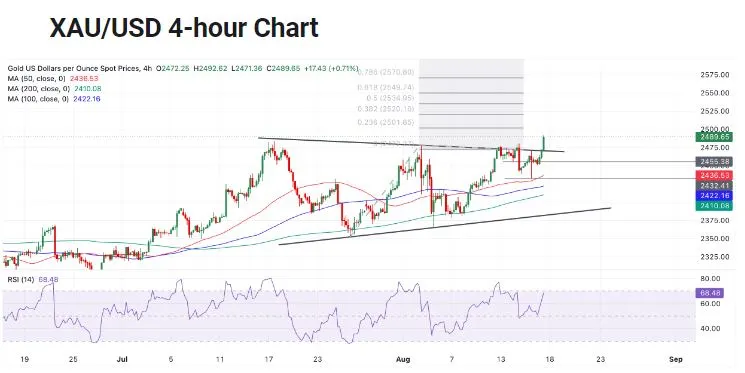The gold price has recently reached a record high, driven by widespread expectations of Federal Reserve rate cuts. As the global economy navigates a complex landscape, investors are increasingly turning to gold. This surge in gold price reflects a broader trend within the precious metals market, where concerns about economic stability often push demand for safe-haven assets. The precious metal is now at the forefront of investor interest, bolstered by recent US retail sales data and a resilient US job market. This article explores the factors behind this historic rise in gold price and what it means for the market going forward.
The Role of Federal Reserve Rate Cuts in the Gold Price Surge
The prospect of Federal Reserve rate cuts is one of the most significant drivers of the recent surge in the gold price. Investors are closely monitoring the Federal Reserve’s monetary policy, anticipating a loosening of interest rates as early as September. Historically, lower interest rates tend to weaken the US dollar. Since gold is primarily priced in dollars, a weaker dollar typically makes gold more affordable for foreign investors, boosting demand and, consequently, the gold price.
Moreover, the Federal Reserve’s actions are often seen as a barometer for economic health. In times of uncertainty, investors flock to gold as a safe-haven asset. The current economic climate, marked by concerns about inflation, global trade tensions, and geopolitical instability, has only heightened the appeal of gold. Thus, the Federal Reserve rate cuts are not just influencing the gold price directly through currency valuation but also by shaping broader investor sentiment within the precious metals market.
Impact of US Retail Sales Data on Gold Price Dynamics
Another critical factor influencing the gold price is the recent US retail sales data. The data showed a stronger-than-expected performance, with retail sales increasing by 1.0% month-over-month in July. This figure exceeded economists’ predictions of a 0.3% rise, signaling a potential turnaround in consumer spending. Such data is crucial because it reflects the health of the US economy, which directly impacts the Federal Reserve’s decisions on interest rates.
However, while robust retail sales data might suggest a resilient economy, it has also created a complex scenario for gold price dynamics. On one hand, strong economic data could lead to a delay in Federal Reserve rate cuts, which might typically dampen gold prices. On the other hand, the ongoing concerns about long-term economic stability, inflation, and potential recessions continue to drive investors toward gold as a safeguard. This tug-of-war between positive economic indicators and underlying fears of instability is playing a pivotal role in the current gold price trends.
The Precious Metals Market: A Broader Perspective
The gold price surge is not occurring in isolation but is part of a broader trend within the precious metals market. This market includes not just gold but also silver, platinum, and palladium. Each of these metals has its unique drivers, but they all share common factors that influence their prices, such as currency fluctuations, geopolitical tensions, and shifts in industrial demand.
In recent months, the precious metals market has seen increased volatility, with prices for all major metals experiencing significant movements. This volatility is often driven by the same factors that influence the gold price, particularly the Federal Reserve’s monetary policy and economic indicators like the US retail sales data. For instance, silver often mirrors gold’s movements but with greater intensity due to its dual role as both an industrial metal and a store of value.
The precious metals market also benefits from the diversification strategies of investors. In times of economic uncertainty, investors tend to diversify their portfolios by increasing their holdings in precious metals. This trend further amplifies the price movements within the market, with gold often leading the charge. The recent surge in gold price can thus be seen as both a reflection of and a contributor to broader trends in the precious metals market.
US Job Market Resilience and Its Influence on Gold Price
The resilience of the US job market is another key factor influencing the gold price. Recent data showed that US Initial Jobless Claims declined to 227,000 from an upwardly revised 234,000. This decline suggests a rebound in the jobs market, which is a positive sign for the overall economy. A strong job market often correlates with increased consumer spending, which in turn boosts economic growth.
However, a resilient job market also complicates the outlook for gold price movements. Typically, a strong economy leads to higher interest rates, which can negatively impact gold prices by strengthening the dollar. Yet, despite these positive indicators, there are still concerns about the long-term sustainability of the US economic recovery. Factors such as inflation, global supply chain disruptions, and geopolitical risks continue to loom large, driving investors to seek refuge in gold.
The interplay between a resilient job market and expectations of Federal Reserve rate cuts creates a nuanced landscape for gold price trends. On one hand, strong economic data could delay rate cuts, potentially putting downward pressure on gold. On the other hand, the persistent demand for gold as a hedge against future uncertainties continues to support its price, keeping it at elevated levels.
Technical Analysis: Gold Price Breaks Out of Its Range

From a technical perspective, the gold price has recently broken out of the trading range it had been confined to since July. This breakout is significant because it suggests that the upward momentum in the price could continue in the near term. The price recently breached a key resistance level in the $2,470 range, a level it had struggled to surpass for several weeks.
This breakout is not just a technical anomaly but rather a reflection of the broader market dynamics at play. The combination of Federal Reserve rate cut expectations, strong US retail sales data, and a resilient US job market has created a perfect storm for gold prices. Technical analysts often use tools like the Fibonacci retracement to predict future price movements. According to this analysis, the next target for gold price could be around $2,550, which would represent a new all-time high.
Future Outlook: What Lies Ahead for Gold Price?
Looking ahead, the gold price is likely to remain highly sensitive to macroeconomic developments. The Federal Reserve’s decisions on interest rates will continue to play a crucial role in shaping the price trends. If the Federal Reserve proceeds with the expected rate cuts in September, we could see further upward pressure on gold prices. However, any signs of economic weakness, such as a slowdown in the US retail sales data or a reversal in the US job market’s resilience, could further fuel demand for gold.
Additionally, global factors such as geopolitical tensions, inflationary pressures, and shifts in industrial demand for other precious metals will also influence the gold price. The precious metals market is interconnected, and movements in one metal often affect the others. Therefore, keeping an eye on the broader market dynamics is essential for understanding the future direction of the price.
Investors should also be mindful of potential risks. While gold has historically been a safe-haven asset, its price can still be volatile, particularly in response to sudden economic or political developments. Diversification remains a key strategy for mitigating risk, and the precious metals market offers a range of options for investors looking to hedge against uncertainty.
Conclusion
In conclusion, the recent surge in gold price is the result of a complex interplay of factors, including expectations of Federal Reserve rate cuts, strong US retail sales data, and the resilience of the US job market. As these factors continue to evolve, so too will the gold price. The broader precious metals market is also likely to remain volatile, influenced by the same macroeconomic trends that are driving gold. Investors should stay informed and consider the potential risks and rewards of investing in gold during these uncertain times.
As we move forward, the price will remain a critical indicator of market sentiment and economic stability. Whether driven by fears of inflation, geopolitical tensions, or changes in Federal Reserve policy, the price of gold is set to remain in the spotlight. For investors, this presents both opportunities and challenges, making it more important than ever to stay engaged with the latest market developments.
Click here to read our latest article Hindenburg Allegations Threaten India’s Market Stability




